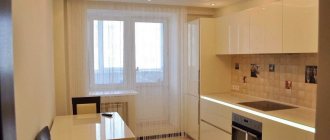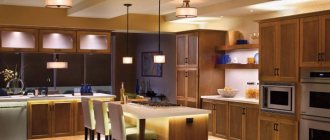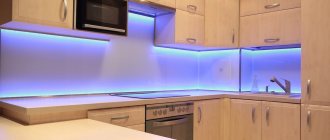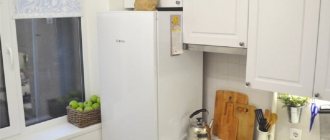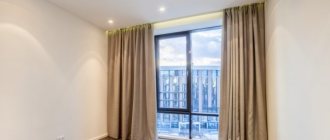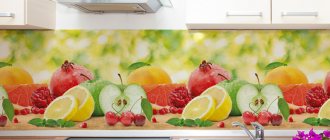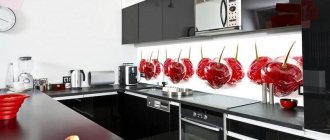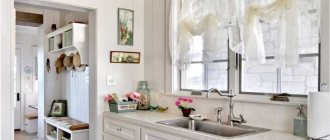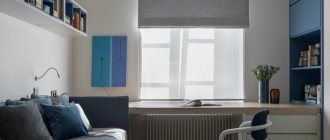LED lamps of various designs are a real boon for housewives.
A relatively new invention, which is gaining popularity, makes it possible to arrange the lighting of the kitchen work area almost perfectly, with millimeter precision.
This was difficult and sometimes almost impossible to do with traditional light sources.
If earlier lighting required expensive repairs and the use of various tricks, now it is enough to think through the lighting scheme and select technical means for it.
And placing lamps on existing surfaces is not difficult at all.
Strip lighting
The convenience of work and the appearance of the interior depend on the correctly selected and positioned lamp. LED lighting for the kitchen work area is becoming increasingly popular. It is a continuous flexible tape dotted with small point diodes, on which the degree of illumination of the room depends. The optimal number of points is considered to be 100-120 diodes per linear meter.
Dining area lighting
The light near the dining table can be made in only two variations: a story sconce, one or several lamps on a long cord from the ceiling.
It is important to maintain the style
You can use the sconce if the table is near the wall. When choosing the location of a wall lamp, we are guided by two considerations: the degree of illumination and convenience. The lamp should not interfere, for which it is placed at a height of 60-80 cm above the tabletop. In order for it to illuminate the entire table, it is advisable to find a model that allows you to move the lamp away from the wall.
An example of the location of sconces above the dining table in the kitchen
To ensure that the lighting in the kitchen is not only bright, but also beautiful, all chandeliers and sconces are selected in the same style, which should also be in harmony with the overall design style.
Advantages of using diode lamps
Modern types of lighting are superior in their parameters to outdated incandescent lamps, energy-saving lamps and other lighting devices.
What types of lamps are there?
Green lighting in the kitchen
In fact, lamps for illuminating the kitchen work area are divided into two types according to the method of their installation, these are:
- Built-in lights. They are built into a piece of furniture and become invisible. The only negative is the installation layout and additional work, such as drilling a hole in the furniture for the lamp.
- Overhead lamps. This light source is attached to the bottom of hanging kitchen cabinets. These lamps are convenient if, for example, you need to replace a light bulb. No special skills or additional work are required to install them.
Interesting! There is a type of lamps, these are clothespin lamps. They are convenient because you can direct the light in the desired direction yourself.
Selecting the backlight
Illumination of work surfaces with LED panels with a pattern
Let's take a closer look at what kind of electric lighting is used in working areas of the house, and what kind of lamps are used, specifically for work tables in the kitchen:
- Linear lighting. Not everyone realizes that linear lamps can also be used to illuminate tables in the kitchen. Moreover, with the help of fluorescent lamps it is easier to save electricity, and they do not irritate the eyes, although they shine quite brightly.
Now there are models of fluorescent lamps in the form of light beams of different lengths, which allows you to illuminate the entire surface of the countertops in the kitchen. Installing such lighting does not require additional skills or costs. However, the price of such light beams is quite high and is not suitable for everyone.
- Spot lighting. Spotlights are often used for the main lighting of a room or to highlight and accent some design or interior element. They are: built-in, overhead and modular.
Light from spotlights is scattered no more than a couple of meters and if a larger lighting radius is needed, special overhead diffusers are used. They can be of various shapes and colors, which makes them easy to apply in any interior.
- Touch backlight. These are lamps with special sensors that respond to touch or movement. This is quite convenient, since your hands often get dirty when cooking. With one clap you can turn on the backlight without dirtying the lamp.
Such lamps come in a variety of shapes and sizes, which allows you to choose the ones you need. The disadvantage of such lighting is the high cost of the lamps and their installation requires special skills, so they are installed by professionals.
- Lighting with LED panels. Such panels not only provide soft light, but also serve as an interior highlight. LED panels consist of two glasses with a variety of illuminated images. This glass is highly tempered, so there is no danger of accidentally breaking it.
The arrangement of internal lamps makes the entire surface evenly illuminated. These panels are becoming very popular, but they are quite expensive and must be installed by specialists. By installing such a panel along the kitchen work area, you will get an unusual and sophisticated interior.
- Neon lights. Typically, neon lights or tubes are used for a decorative look, as they most often come in different colors. With this lighting, the kitchen will look cozy and mysterious, and if you set the color changing mode, this will create a festive atmosphere.
More often, neon lamps are used to illuminate suspended ceilings, but they also look interesting and original in kitchen cabinets. When creating a specific interior in the kitchen, it will not be a problem to choose the right color scheme.
- LED lights. LED strip is very common for lighting and not only in the kitchen. It is economical, gives good soft light and can be used for decoration, as it comes in different colors. This tape is easy to install; it sticks to any surface using an adhesive backing.
Such lighting is considered ideal for the kitchen work area, as it has a number of advantages: they are not afraid of humidity and dirt, they tolerate temperature changes well, they are easy to care for and can be wiped with an important rag.
Lighting rules
Yellow LED lighting
It is necessary to think through the lighting of the room even before the start of renovation work, since with the help of light and lighting you can radically change both the room itself and its interior.
It can create an atmosphere:
- Works.
- Romantics.
- Relaxation.
When thinking about the location of lamps and their connection to the network, it is worth knowing:
- Make separate power points for connecting to the electrical network.
- Place lamps and sockets no closer than 60 centimeters to the sink and stove.
When choosing lighting, you need to take into account the general light in the kitchen; when lighting, the illumination should be:
- Using halogen lamps - 30 watts per square meter.
- Using fluorescent lamps - 9 watts per square meter.
- Using incandescent lamps - 26 watts per square meter.
- Using LED lamps - 4 watts per square meter.
A few design secrets for choosing light:
- White light does not distort the color of food.
- Colored lighting is good to use when zoning a room.
- It would be good if the backlight could be adjusted according to brightness.
- If you have a wooden kitchen set, choose warm lighting, for example, yellow light.
- If your kitchen is made in modern styles, for example, high-tech, silver light will do.
- To prevent the color of food from changing, it is better to choose lamps of warm white light.
Interesting! Lighting can be not only on wall cabinets or walls; you can also make a backlit work surface, for example, using LED panels.
Product selection
Wide range of colors. Lamps for illuminating the work area in the kitchen are produced in all colors of the rainbow palette, from milky white to muted yellowish and cold blue.
At the customer's request, the flow of emitted light can be static, programmable depending on the time of day and daylight.
Kitchen lighting design
Despite the variety of types of lamps, solving the problem of illumination of only the working area is not entirely correct. Proper lighting will allow you not only to cook comfortably, but also to spend time with family and friends.
Light sources can be divided into three types according to location: countertop, stove, kitchen set.
Decorative - lighting of cabinets or plinths. They can be easily decorated using fluorescent lamps or diode strips. Drawer lighting is usually done using spotlights.
Fig.22.
Illumination of various elements of the kitchen unit not only makes the work area comfortable, but also becomes a decoration.
Kitchen lighting is no less important than other types. This type covers much more space and compensates for the disadvantages of directional light from other sources. So it can be turned on when bright lighting is not required.
Varieties of the latest lighting
Flexible designs and ready-made modular frames of lighting fixtures are conveniently built into any interior and have a directed beam of light, which greatly facilitates the work process. Among them are ready-made and locally assembled structures used indoors and outdoors.
Application of LED strip
There is no type of lighting fixture that is more flexible to use than LED strip. It is generally ideal for lighting the kitchen work area. And this ideality is possible both from a technical and design point of view.
The LED strip can be placed so that it is not visible at all, and so that it becomes an independent design element. For example, an original spiral on a special drum will decorate any surface.
Again, there are hundreds of options for implementing this type of lighting. You just need to take care of the power supply, so that the wires, controllers and other equipment remain invisible.
LED strips, or more precisely, LED elements on strips, differ in lighting intensity. The intensity is distributed among economy, standard and premium versions.
When choosing the appropriate option, you should remember that the work area should be well lit; it will be difficult for the housewife to work in the dark.
A waterproof LED strip is useful when there is a chance of water getting on it. For example, if such a device is installed above a sink, additional moisture protection will not be superfluous.
Some nuances of working with LED strip
LED strip is mainly sold in five-meter rolls. This is important to consider when calculating the amount of material.
- The tape can only be cut in places marked by the manufacturer.
- When connecting the adapter, the main thing is to remember the correct polarity.
- Space for the power supply should be provided separately. It is not as invisible as the tape itself, and sometimes it is quite difficult to hide.
Installing the tape yourself is not a difficult task, but it requires a certain amount of caution and scrupulousness.
Directional light systems
Spotlights are convenient because they allow you to adjust the illumination of a specific area. Acting with direct directional light, they provide the workplace with sufficient light.
Depending on the power of one spotlight, their number per unit area varies. They allow you to make light accents not over the entire area of the room, but in separate areas.
The range includes options in metal and plastic housings for manual and remote control for smart home systems.
Note!
- Linoleum for the kitchen - master classes on installing linoleum in the kitchen interior. The best design ideas and color schemes (120 photos)
- Stretch ceiling in the kitchen - TOP-130 design options for stretch ceiling in the kitchen + photo examples
Photo wallpaper for the kitchen - TOP-170 photos of new wallpaper designs. Types of materials, options for modern pictures for the kitchen
Indoor luminaires
Built-in (mortise). The most labor-intensive systems require certain skills and tools to install. They stand out due to their inconspicuous structures that are hidden inside cabinets, plasterboard or suspended ceilings.
What are the benefits of spotlights and spots?
The use of spotlights is often the ideal solution. But, unfortunately, not always. The main disadvantages of using such devices:
It is not always possible to provide uniform illumination of the work area with spotlights. Firstly, they shine with a directional beam, which limits the possibilities of their application. Secondly, such equipment cannot be attached to all surfaces.
Candle atmosphere: main types of candles for the home- Where can I find a gift?
Schemes for the location of spotlights in the kitchen
Often, spotlights mounted on a kitchen cabinet look out of place. We must try very hard to ensure that they fit harmoniously into the interior. Or design the interior, not forgetting the presence of such lamps.
Lighting the work area with spots looks more effective. But when implementing this solution, it should be taken into account that the direction of the beam in such devices cannot be adjusted.
Therefore, the uniformity of lighting should be checked before the spots are completely secured at the site of further use.
Spots can be attached in various ways. For this purpose, for example, roof rails are used. This is a pipe to which you can attach a number of small spots.
Product range
The photo of the lighting of the work area in the kitchen shows a catalog of various models of lighting fixtures. Our experts advise that before purchasing, be sure to familiarize yourself with the characteristics, the effect of lighting the room in different interiors and styles, and decide on the color of the lamp.
On the website you can order a computer model of the location of the selected lamps, taking into account the individual parameters of the room and the wishes of the customer. Lighting can completely transform the kitchen environment, making it unique, bright and comfortable.
Principles and requirements
A kitchen is a room in which there are at least two zones with different purposes - a work area for cooking and a dining area. Different purposes also lead to different requirements for kitchen lighting: the work area should have bright lighting, allowing you to see everything clearly, and the dining area should have softer lighting.
It is better to make lighting in the kitchen zoned
But zoned kitchen lighting does not exclude the presence of a chandelier. Its functional significance is small, since the light spot is obtained in the center of the room, which remains mostly empty. But from the point of view of leveling out uneven illumination, this method is very good. As an option, you can use several spotlights, as in the photo above, or install built-in ceiling lights if the ceiling is suspended or suspended from plasterboard.
You need to think about kitchen lighting at the renovation stage, when the electrical panel is being assembled, the wiring is being installed, and the installation locations of sockets and switches are marked. Later, after the repair is completed, this is very problematic - you have to lay the wiring on top or in cable channels.
Illumination standards
When you are just planning lighting in the kitchen, the question arises of how many lamps are needed and what power. It's simple: there are lighting standards for each room for the kitchen - 150 Lux per square meter of area. Calculating illumination in Watts is no longer relevant, since a 7 W LED lamp can produce light like a 50 W incandescent lamp or 650 lm.
For example, let’s calculate how much light is required for a kitchen with an area of 12 m2. To do this, we multiply its area by the norm: 12 m2 * 150 Lx = 1800 Lx. And since 1 Lux is equal to 1 Lumen, it is necessary to install light bulbs that in total give at least 1800 Lm.
With zoned lighting, the amount of light required is calculated separately for each zone
If you decide to do zoned lighting, that is, the work surface will be illuminated separately, there will be a light source above the table, it makes sense to count everything separately. To do this, the kitchen plan must be divided into zones, the area must be calculated, and based on these figures, the number of lamps and lamps for them must be selected. Just keep in mind that two 50 W lamps in total will not give as much light as one 100 W lamp, but about 1/3 less.
Lamp type, color and light
Another important point. When selecting lighting, it is best to choose lamps of the same type: halogen, LED, daylight. As a last resort, you can combine two types, but it is better not to use all three. They provide different lighting and it is almost impossible to get a sane result. We are not talking about incandescent lamps, since they are used very rarely: they require too much electricity, producing a small amount of light.
When choosing lamps, it is necessary to take into account their color temperature
In addition to the type of lamps, you need to choose lamps that produce light of the same color, which is also called the color temperature of the lamps. They can produce light with blue, yellow, and white tints. Basically, it’s up to you to choose, but the best option is natural or neutral. It is better for the eyes and for color perception.

